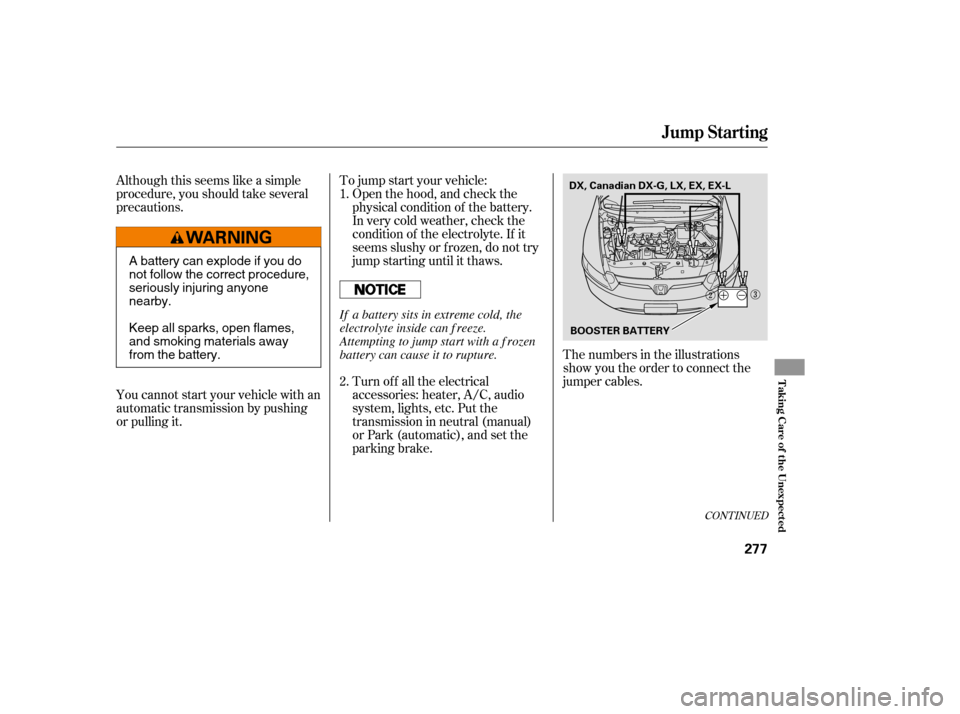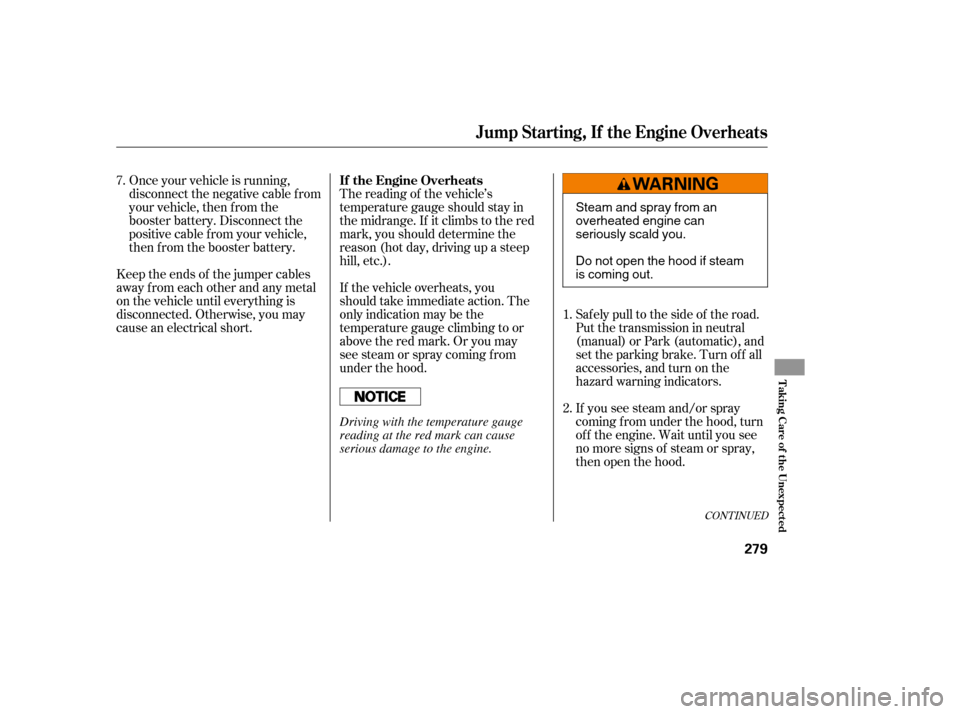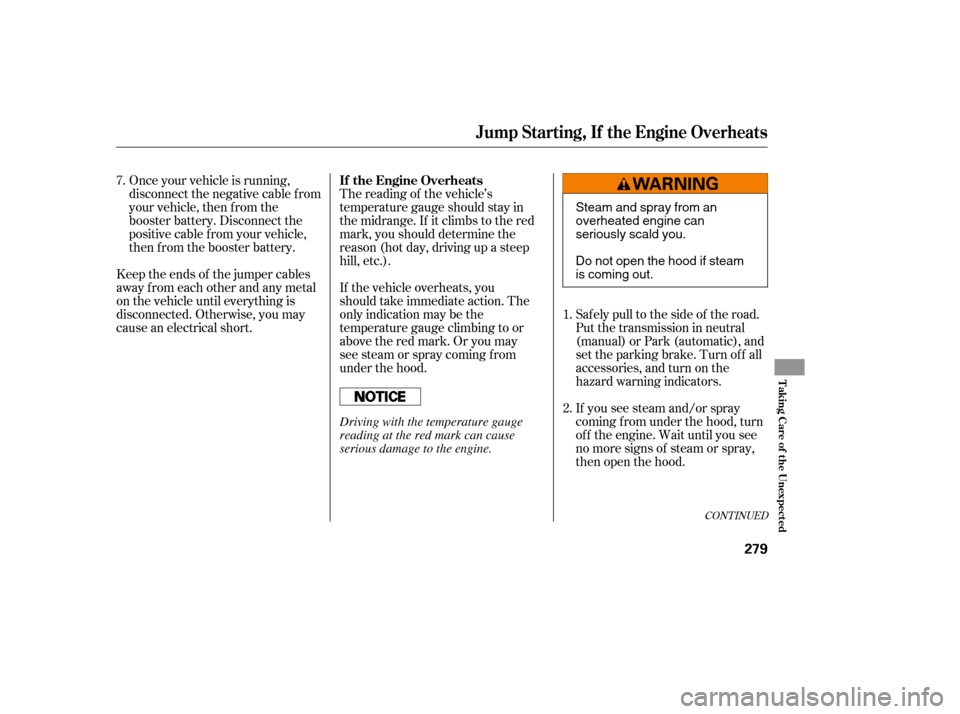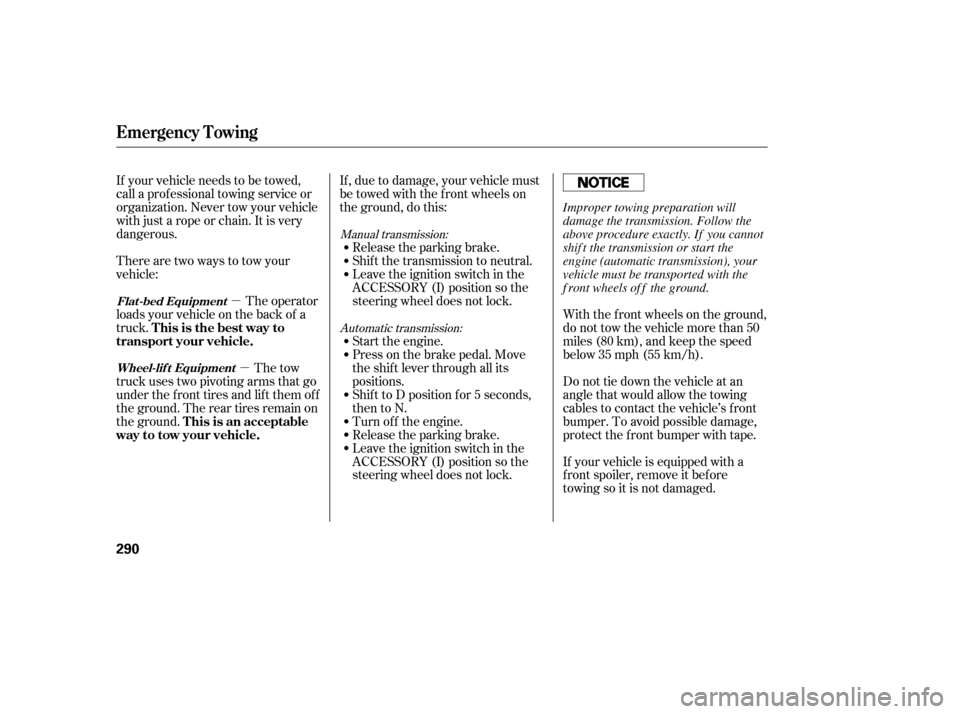Page 252 of 303
CONT INUED
Bef ore mounting the spare tire,
wipe any dirt of f the mounting
surface of the wheel and hub with
a clean cloth. Wipe the hub
carefully;itmaybehotfrom
driving.
Use the extension and the wheel
nut wrench as shown to raise the
vehicle until the f lat tire is of f the
ground.
Remove the wheel nuts, then
remove the f lat tire. Handle the
wheel nuts caref ully; they may be
hot f rom driving. Place the f lat tire
on the ground with the outside
surface facing up. Do not attempt to forcibly pry the
wheel cover of f with a screwdriver
or other tool. The wheel cover
cannot be removed without f irst
removing the wheel nuts.
11.
9.
10.DX, and U.S. LX models
Changing a Flat T ire
T aking Care of t he Unexpect ed
273
WHEEL NUTS WHEEL COVER BRAKE HUB
WHEEL NUTS
WHEEL NUT WRENCH EXTENSION
�����—�����—�
�
�y�
�������������y���
�(�+���������y���������y
Page 257 of 303

Although this seems like a simple
procedure, you should take several
precautions.Open the hood, and check the
physical condition of the battery.
In very cold weather, check the
condition of the electrolyte. If it
seems slushy or f rozen, do not try
jump starting until it thaws.
You cannot start your vehicle with an
automatic transmission by pushing
or pulling it. To jump start your vehicle:
Turn of f all the electrical
accessories: heater, A/C, audio
system, lights, etc. Put the
transmission in neutral (manual)
or Park (automatic), and set the
parking brake. The numbers in the illustrations
show you the order to connect the
jumper cables.
1. 2.
CONT INUED
Jump Start ing
T aking Care of t he Unexpect ed
277
BOOSTER BATTERY
DX, Canadian DX-G, LX, EX, EX-L
A battery can explode if you do
not follow the correct procedure,
seriously injuring anyonenearby.
Keep all sparks, open flames,
and smoking materials away
from the battery.
If a battery sits in extreme cold, the
electrolyte inside can f reeze.
Attempting to jump start with a f rozen
battery can cause it to rupture.
�����—�����—�
�
�y�
�������������y���
�(�+���������y���������y
Page 259 of 303

CONT INUED
Once your vehicle is running,
disconnect the negative cable f rom
your vehicle, then f rom the
booster battery. Disconnect the
positive cable f rom your vehicle,
then from the booster battery.
Keep the ends of the jumper cables
away from each other and any metal
on the vehicle until everything is
disconnected. Otherwise, you may
cause an electrical short. If the vehicle overheats, you
should take immediate action. The
only indication may be the
temperature gauge climbing to or
above the red mark. Or you may
see steam or spray coming f rom
under the hood.
If you see steam and/or spray
coming f rom under the hood, turn
of f the engine. Wait until you see
no more signs of steam or spray,
then open the hood.
The reading of the vehicle’s
temperature gauge should stay in
the midrange. If it climbs to the red
mark, you should determine the
reason (hot day, driving up a steep
hill, etc.).
Saf ely pull to the side of the road.
Put the transmission in neutral
(manual) or Park (automatic), and
set the parking brake. Turn of f all
accessories, and turn on the
hazard warning indicators.
7.
1. 2.
Jump Start ing, If t he Engine Overheat s
If the Engine Overheats
T aking Care of t he Unexpect ed
279
Steam and spray from an
overheated engine can
seriously scald you.
Do not open the hood if steam
is coming out.
Driving with the temperature gauge
reading at the red mark can cause
serious damage to the engine.
�����—�����—�
�
�y�
���������
���y���
�(�+���������y���������y
Page 260 of 303

CONT INUED
Once your vehicle is running,
disconnect the negative cable f rom
your vehicle, then f rom the
booster battery. Disconnect the
positive cable f rom your vehicle,
then from the booster battery.
Keep the ends of the jumper cables
away from each other and any metal
on the vehicle until everything is
disconnected. Otherwise, you may
cause an electrical short. If the vehicle overheats, you
should take immediate action. The
only indication may be the
temperature gauge climbing to or
above the red mark. Or you may
see steam or spray coming f rom
under the hood.
If you see steam and/or spray
coming f rom under the hood, turn
of f the engine. Wait until you see
no more signs of steam or spray,
then open the hood.
The reading of the vehicle’s
temperature gauge should stay in
the midrange. If it climbs to the red
mark, you should determine the
reason (hot day, driving up a steep
hill, etc.).
Saf ely pull to the side of the road.
Put the transmission in neutral
(manual) or Park (automatic), and
set the parking brake. Turn of f all
accessories, and turn on the
hazard warning indicators.
7.
1. 2.
Jump Start ing, If t he Engine Overheat s
If the Engine Overheats
T aking Care of t he Unexpect ed
279
Steam and spray from an
overheated engine can
seriously scald you.
Do not open the hood if steam
is coming out.
Driving with the temperature gauge
reading at the red mark can cause
serious damage to the engine.
�����—�����—�
�
�y�
���������
���y���
�(�+���������y���������y
Page 264 of 303

However, if the brake pedal does not
f eel normal, you should take
immediate action. A problem in one
part of the system’s dual circuit
design will still give you braking at
two wheels. You will f eel the brake
pedal go down much f arther bef ore
the vehicle begins to slow down, and
you will have to press harder on the
pedal.
If you must drive the vehicle a short
distance in this condition, drive
slowly and caref ully.
Slow down by shif ting to a lower
gear, and pull to the side of the road
when it is saf e. Because of the long
distance needed to stop, it is
hazardous to drive the vehicle. You
should have it towed and repaired as
soon as possible (see
on page ).
If the f luid level is low, take your
vehicle to a dealer, and have the
brake system inspected f or leaks or
worn brake pads.
If the brake system indicator comes
on while driving, the brake f luid level
is probably low. Press lightly on the
brake pedal to see if it f eels normal.
If it does, check the brake f luid level
thenexttimeyoustopataservice
station (see page ). The brake system
indicator normally
comes on when
you turn the ignition switch to the
ON (II) position and as a reminder to
check the parking brake. It will stay
on if you do not f ully release the
parking brake. If the ABS indicator and the VSA
system indicator (if equipped) come
on with the brake system indicator,
have your vehicle inspected by your
dealer immediately.
244 290Emergency
Towing
Brake System Indicator
T aking Care of t he Unexpect ed
283
Canada
U.S.
�����—�����—�
�
�y�
�������������y���
�(�+���������y���������y
Page 265 of 303
The vehicle’s f uses are contained in
two f use boxes.If something electrical in your
vehicle stops working, check f or a
blown f use f irst. Determine f rom the
chart on pages and , or the
diagram on the f use box lid, which
f use or f uses control that device.
Check those f uses f irst, but check all
the f uses bef ore deciding that a
blown f use is the cause. Replace any
blown f uses, and check if the device
works.
The interior f use box is on the
driver’s lower lef t side. The under-hood f use box is in the
engine compartment on the driver’s
side, next to the brake f luid reservoir.
To open it, push the tabs as shown. 288 289
Fuses
Checking and Replacing Fuses
284
UNDER-HOOD
INTERIOR
TAB
�����—�����—�
�
�y�
�������������y���
�(�+���������y���������y
Page 271 of 303

�µ�µ If , due to damage, your vehicle must
be towed with the f ront wheels on
the ground, do this:
If your vehicle needs to be towed,
call a prof essional towing service or
organization. Never tow your vehicle
with just a rope or chain. It is very
dangerous.
Therearetwowaystotowyour
vehicle:
The operator
loads your vehicle on the back of a
truck.
The tow
truck uses two pivoting arms that go
under the f ront tires and lif t them of f
the ground. The rear tires remain on
the ground. Release the parking brake.
Shif t the transmission to neutral.
Leave the ignition switch in the
ACCESSORY (I) position so the
steering wheel does not lock.
Do not tie down the vehicle at an
angle that would allow the towing
cables to contact the vehicle’s f ront
bumper. To avoid possible damage,
protect the f ront bumper with tape.
With the f ront wheels on the ground,
do not tow the vehicle more than 50
miles (80 km), and keep the speed
below35mph(55km/h).
If your vehicle is equipped with a
f ront spoiler, remove it bef ore
towing so it is not damaged.
Start the engine.
Press on the brake pedal. Move
the shif t lever through all its
positions.
Leave the ignition switch in the
ACCESSORY (I) position so the
steering wheel does not lock.
Release the parking brake.
Turn of f the engine.
Shif t to D position f or 5 seconds,
then to N.
Manual transmission:
Automatic transmission:
Flat -bed Equipment
Wheel-lif t Equipment
T his is the best way to
transport your vehicle.
This is an acceptable
way to tow your vehicle.
Emergency T owing
290
Improper towing preparation will
damage the transmission. Follow the
above procedure exactly. If you cannot
shif t the transmission or start the
engine (automatic transmission), your
vehicle must be transported with the
f ront wheels of f the ground.
�����—�����—�
�
�y�
�������������y���
�(�+���������y���������y
Page 275 of 303

�µ�µ
�Î �Î �Î�Î �Î�µ�µ�µ �µ �µ�µ�µ�µ�µ�µ�µ�µ
�Î
�Î �Î
�Î �Î�Î�Î�Î�Î
�Î�Î�Î�Î�Î�Î�Î�Î�Î�Î
Specif ications
T echnical Inf ormation
297
Air Conditioning
Lights
Capacities
Refrigerant type
Charge quantity
Lubricant oil typeHFC-134a (R-134a)
14.1 15.9 oz (400 450 g)
SP-10
Headlights (HI)
Headlights (LO)
Front turn signal/Side marker/
Parking light
Rear turn signal lights
Stop/Taillights
Rear side marker lights
Back-up lights
High-mount brake light
License plate lights
Ceiling light
Spotlights
Trunk light 60 W
12 V
12 V
12 V
12 V
12 V
12 V
12 V
12 V
12 V
12 V
12 V
12 V 51 W
28/8 W
21 W
21/5 W
3CP
18 W
21 W
3CP8W8W5W
Including the coolant in the reserve tank and that remaining in
the engine
Reserve tank capacity:
Excluding the oil remaining in the engine 13.2 US gal (50)
1.45 US gal (5.5)
1.37 US gal (5.2)
1.19 US gal (4.5)
1.88 US gal (7.1)
1.72 US gal (6.5)
1.80 US gal (6.8)
3.9 US qt (3.7
)
4.6 US qt (4.4)
3.7 US qt (3.5)
4.4 US qt (4.2)
4.8 US qt (4.5)
5.8 US qt (5.5)
1.5 US qt (1.4)
1.6 US qt (1.5)
1.7 US qt (1.6)
1.8 US qt (1.7)
2.5 US qt (2.4)
6.2 US qt (5.9)
2.6 US qt (2.5
)
4.8 US qt (4.5)
0.11 US gal (0.4
)
Fuel tank
Engine
coolant
Engine oil Manual
transmission
fluid Automatic
transmission
fluid
Windshield
washer
reservoir
Change Total
Change
Including
filter
Without filter
Total
ChangeTotal
Change Total
U.S. Vehicles
Canada
Vehicles Approx.
1: 2: 3:
4: Si A/T
M/T
A/T
M/T
:(HB3)(HB4)
EX, EX-L, Si:
Canada: DX, DX-G, LX, EX, EX-L
U.S.: DX, LX, EX, EX-L Replacement of the light should be done by yourdealer.
U.S. DX and LX
Canada: DX, DX-G, LX
1 2 3 34334
3434343434
�����—�����—�
�
�y�
�������������y���
�(�+���������y���������y